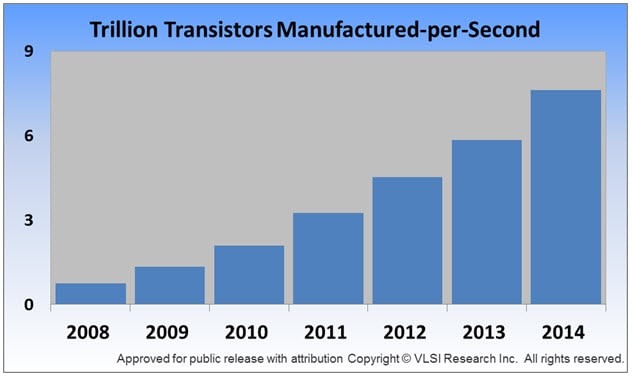What is Moore’s Law and Why is it So Great?
Thursday, Apr 16, 2015, 2:30pm
by Semiconductor Industry Association
April 19 marks the 50th anniversary of the publication of Gordon Moore’s seminal article in Electronics Magazine, which laid out the pace at which semiconductor technology advancement would occur. This observation, which has come to be known as “Moore’s Law,” states that the number of transistors on a semiconductor would double every two years, thereby rapidly increasing the functionality of semiconductors and the electronic products they enable.
Today, some semiconductors contain billions of transistors, and the transformation of certain downstream products because of this functionality growth has become almost a cliché – think of the comparison of the “brick” phone of the 1980s to the much more powerful smartphones of today!
When you add it all up, the number of transistors that are created today by the semiconductor industry is simply mind-blowing. Dan Hutcheson of VLSI Research has calculated that 7.6 trillion transistors were produced in 2014 per second. PER SECOND!!! Hutcheson puts this number in perspective by making some compelling analogies: 7.6 trillion is “…25.4 times more stars in the Milky Way … or 76.1 times more Galaxies in the universe.” And my personal favorite: “… if every transistor was worth one dollar, our industry would pass World GDP in about 10 seconds.”

Here are a couple additional facts related to Moore’s Law from SIA’s “It All Starts Here” industry pocket guide:
1) If Moore’s Law were applied to the auto industry, a typical family sedan from 20 years ago would today have the same horsepower as a large passenger jet engine.
2) If Moore’s Law were applied to light bulbs, a 60-watt incandescent bulb from 20 years ago would today contain enough wattage to light a high school football stadium.
One often overlooked yet critical aspect of Moore’s Law has less to do with the engineering feat it describes and more to do with the economic benefits it suggests. Moore’s Law has enabled the semiconductor industry to operate in a constant state of deflation, where the computational power of semiconductors has grown exponentially while the cost has not. This phenomenon is quite unique. The cost of most products in our economy typically increases over time due to inflation.
Think of any consumer product and think of the observation often made by a member of an older generation to a member of a younger generation that often goes something like this: “When I was your age, the cost of X product was a small fraction of what it costs today!” It is this critical economic piece to Moore’s Law that makes the industry unique.
One way to think about this economic impact is to contemplate the comparative cost of the two examples immediately above. If these were semiconductors, the car with the horsepower of a jet engine would cost today the same as the car from two decades ago and the light bulb with the wattage of a football stadium would cost today the same as a modest 60-watt bulb from the 1990s. Not a bad deal for the consumer!
So as our industry reflects upon 50 years of Moore’s Law, let us commemorate both the shear engineering achievement of maintaining the pace of Moore’s Law for so many decades, as well as the economic benefits it has provided to the world.